Abstract
Four rats were exposed to an A-B-A-B series of 30 sessions each of variable-ratio 20 (A) and fixed-interval 30-s (B) schedules. Four other rats received 120 sessions of fixed-interval 30 s. The rats with a history of variable-ratio responding subsequently showed primarily high or low response-rate patterns on the fixed-interval schedule without evidence of classical scalloping (i.e., increased rates of responding throughout the interreinforcement interval), except infrequently in 1 rat. The rats exposed to only the fixed-interval 30-s schedule displayed the expected sequence of scalloping giving way to lower rate break-run or simply low-rate responding over time. This experiment shows that when naive rats are exposed to even a simple history of reinforcement (in this case, a variable-ratio 20), their subsequent fixed-interval performance is very different from comparable performance in naive rats, and might be said to be more similar to the responding of adult humans. The argument is made that care should be taken in comparing the fixed-interval performance of humans and nonhumans because humans have a complex history of reinforcement, whereas laboratory nonhumans are typically naive.
Full text
PDF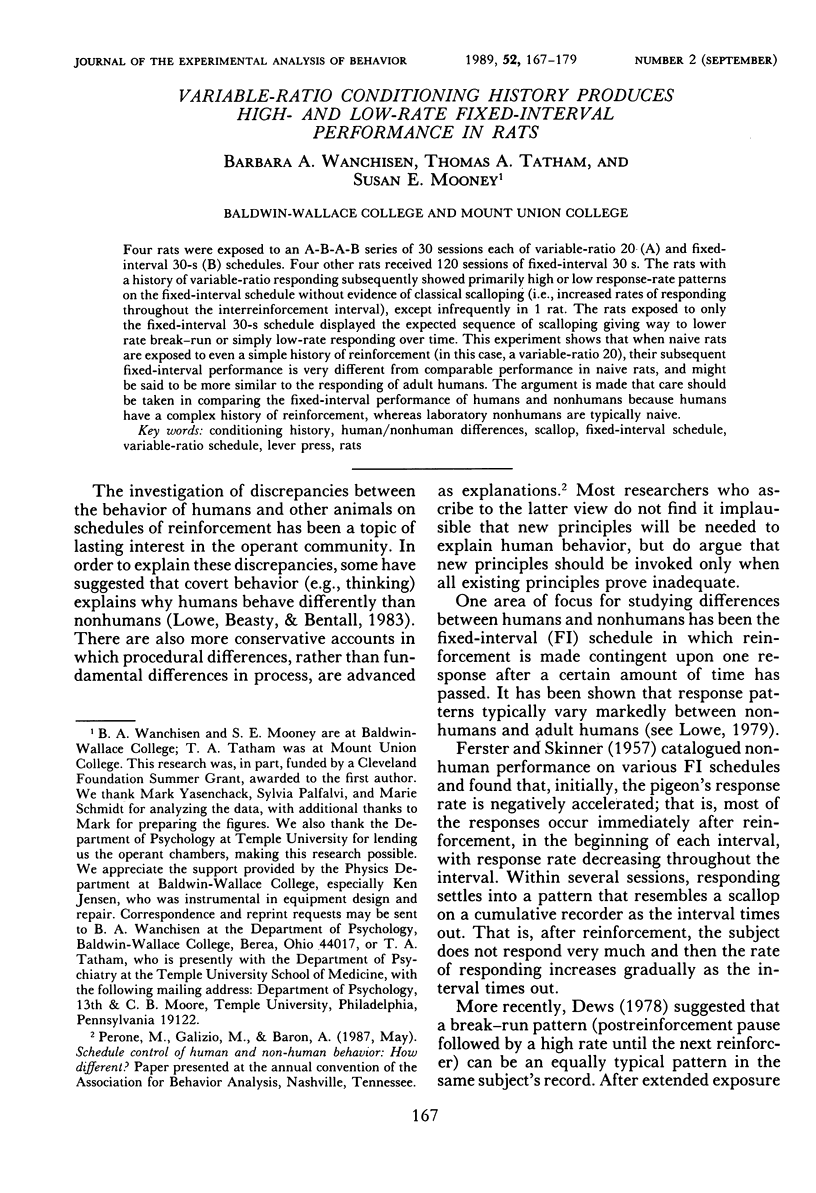
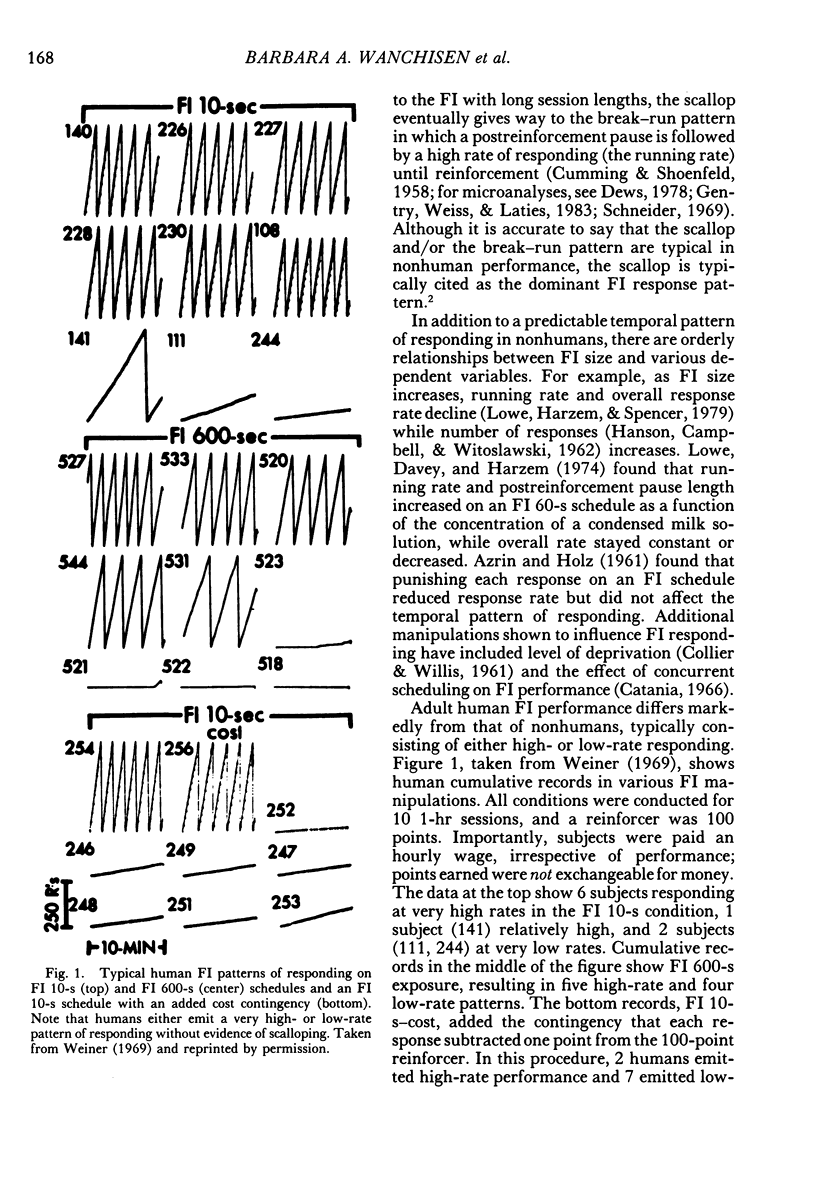
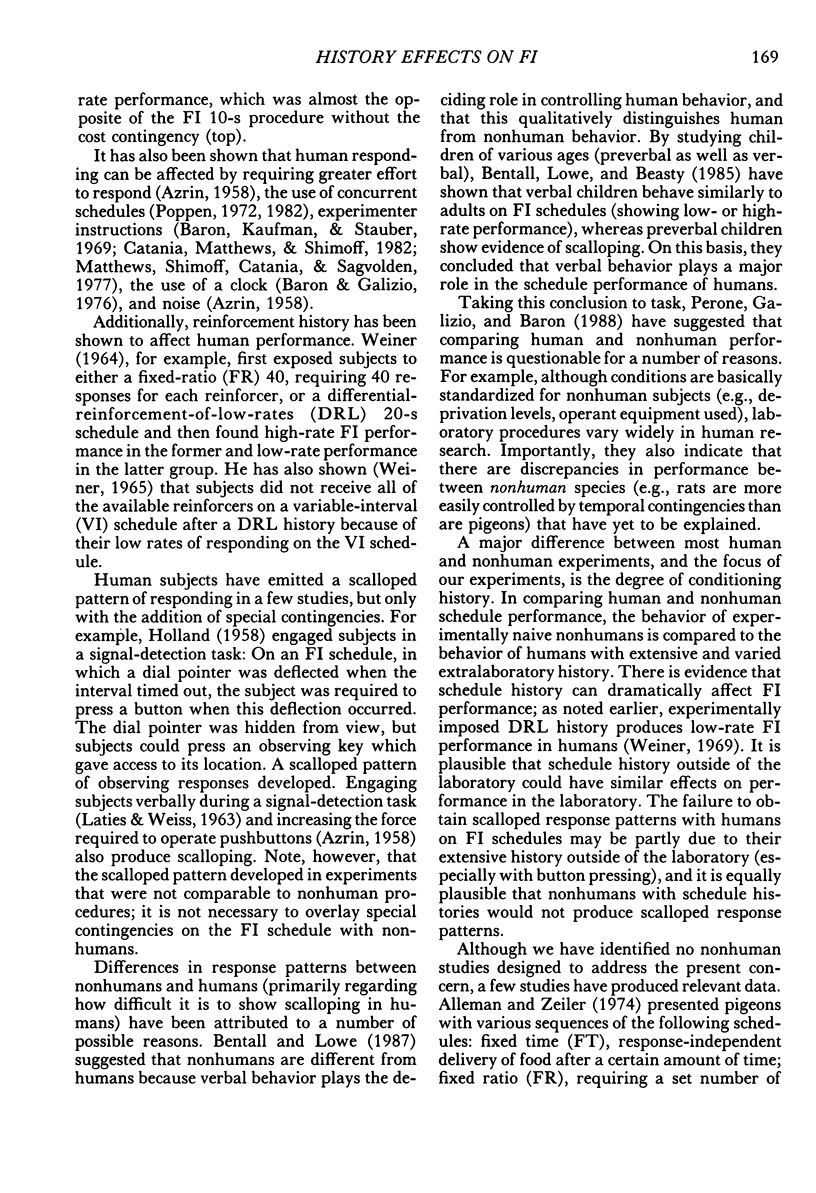
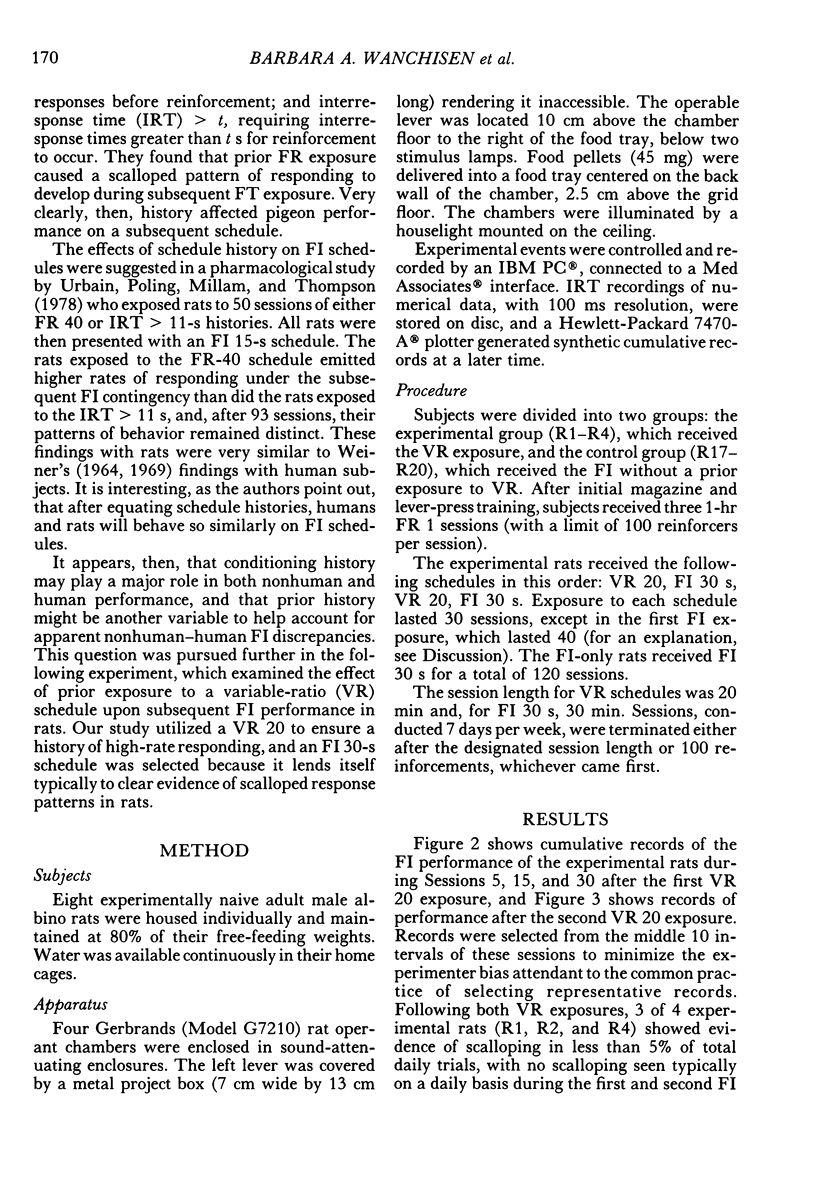
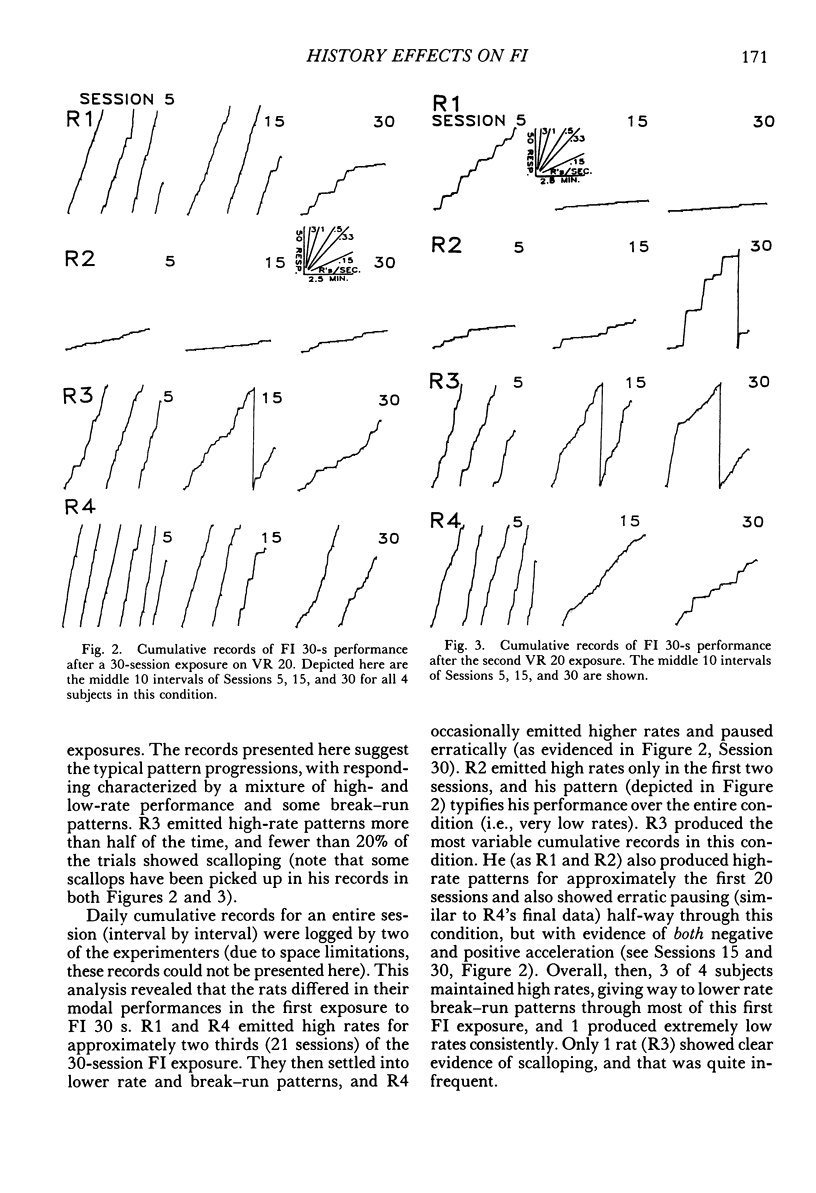

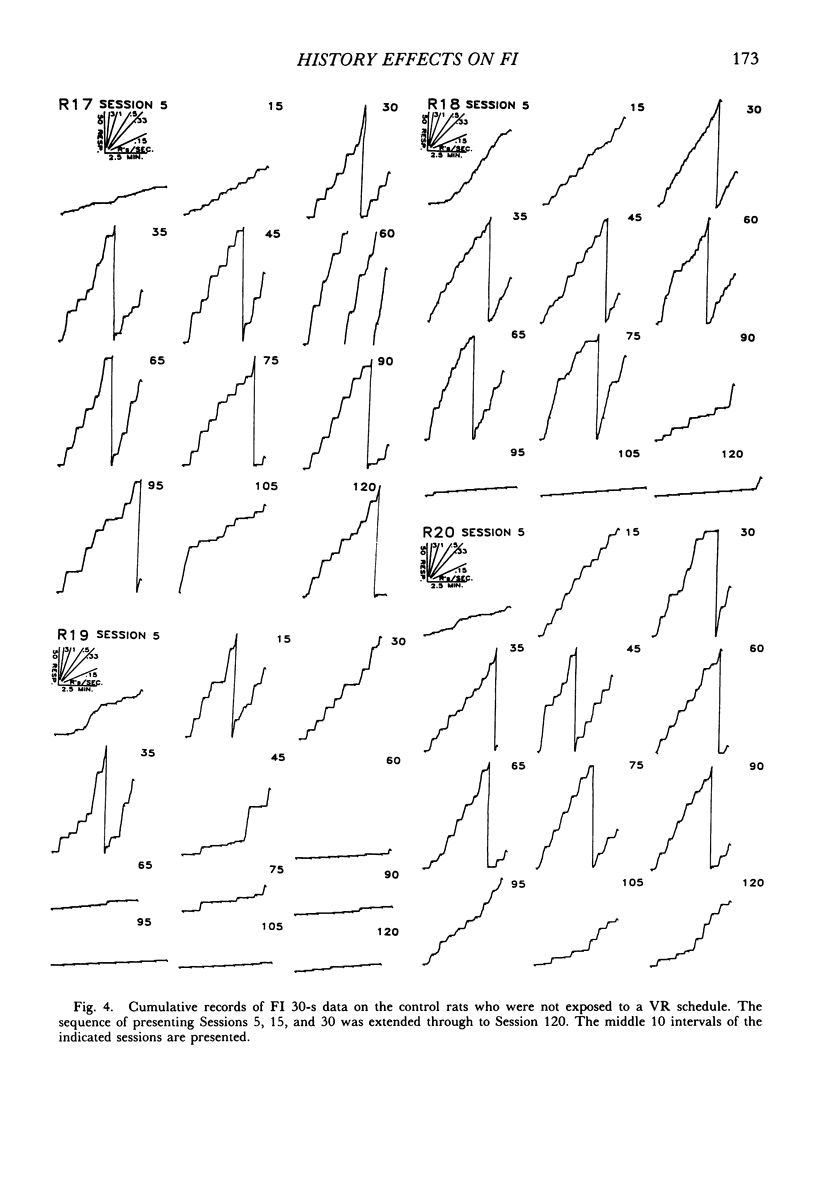
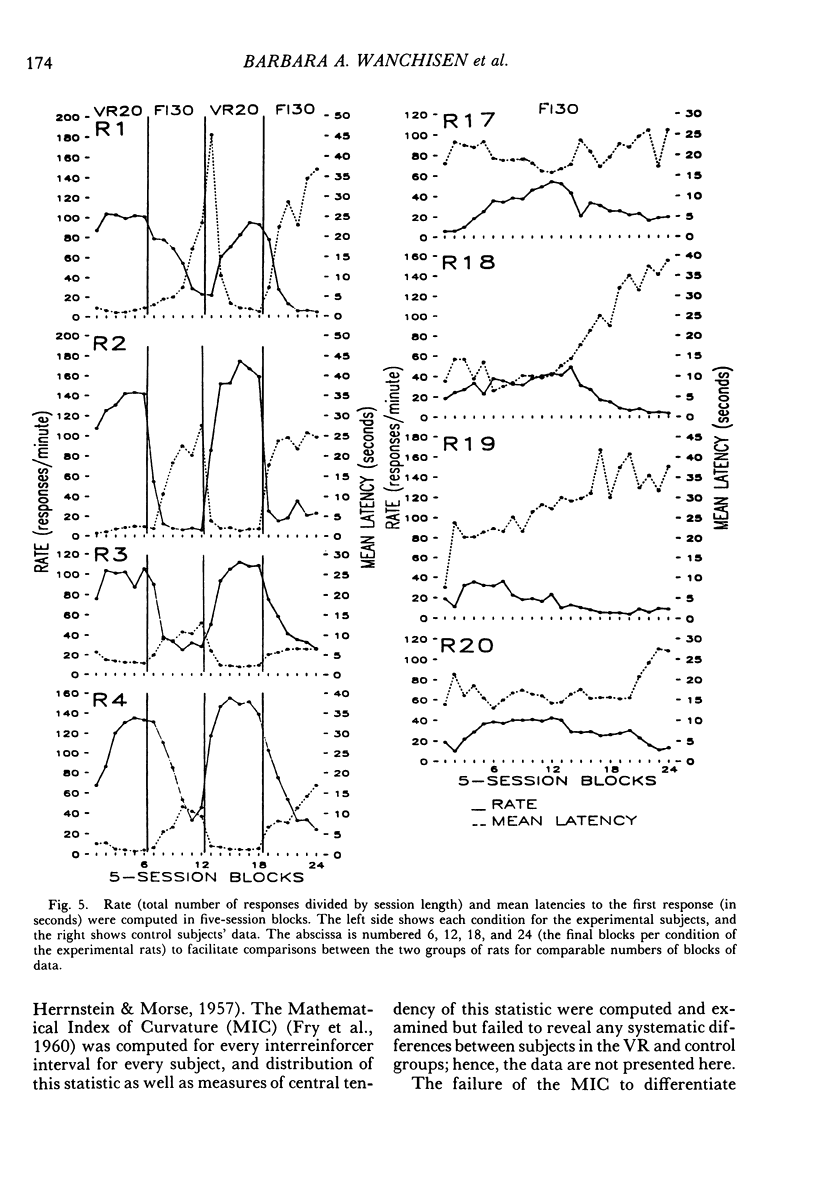
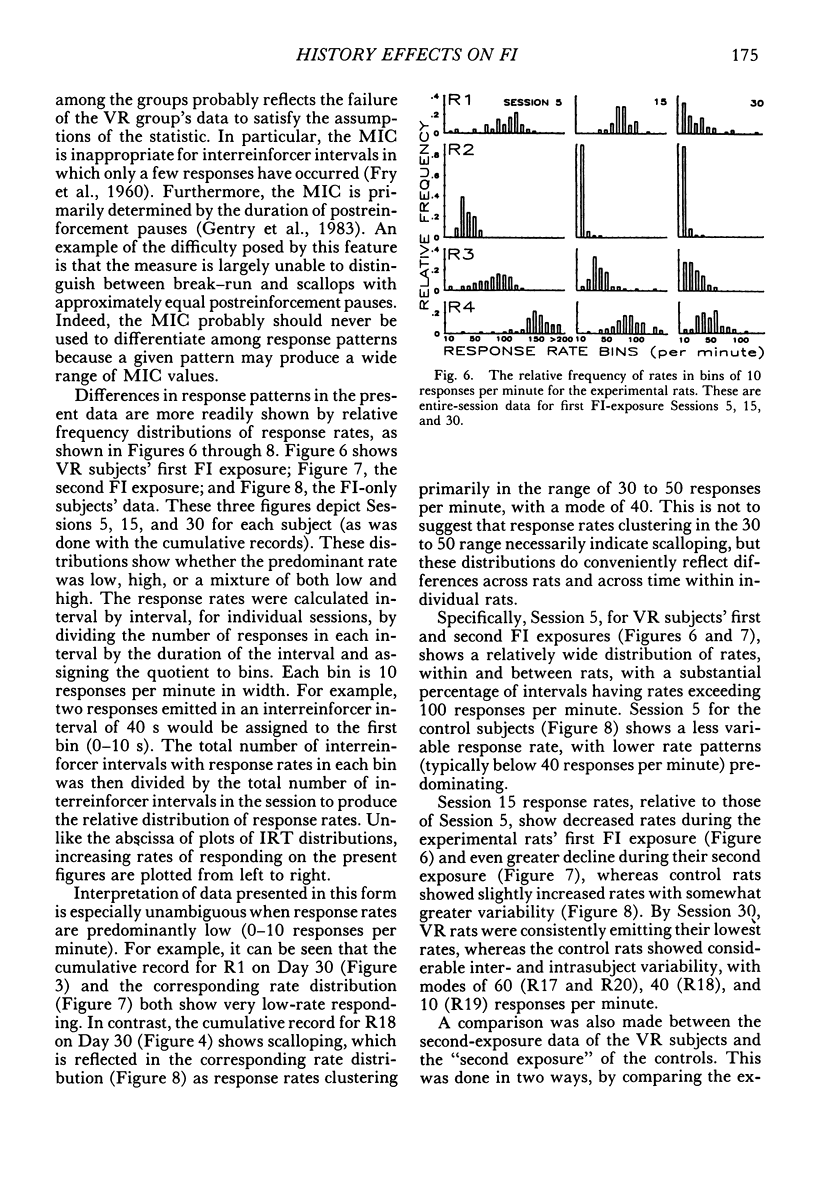
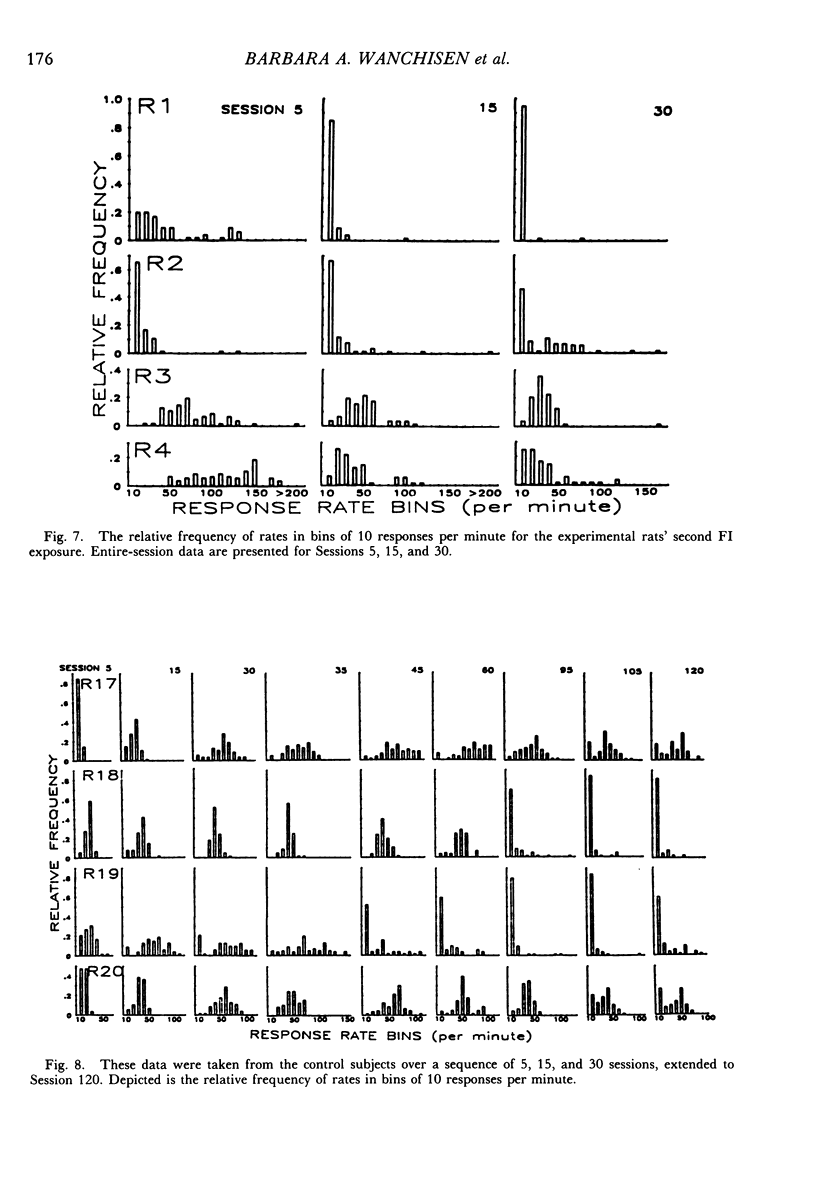
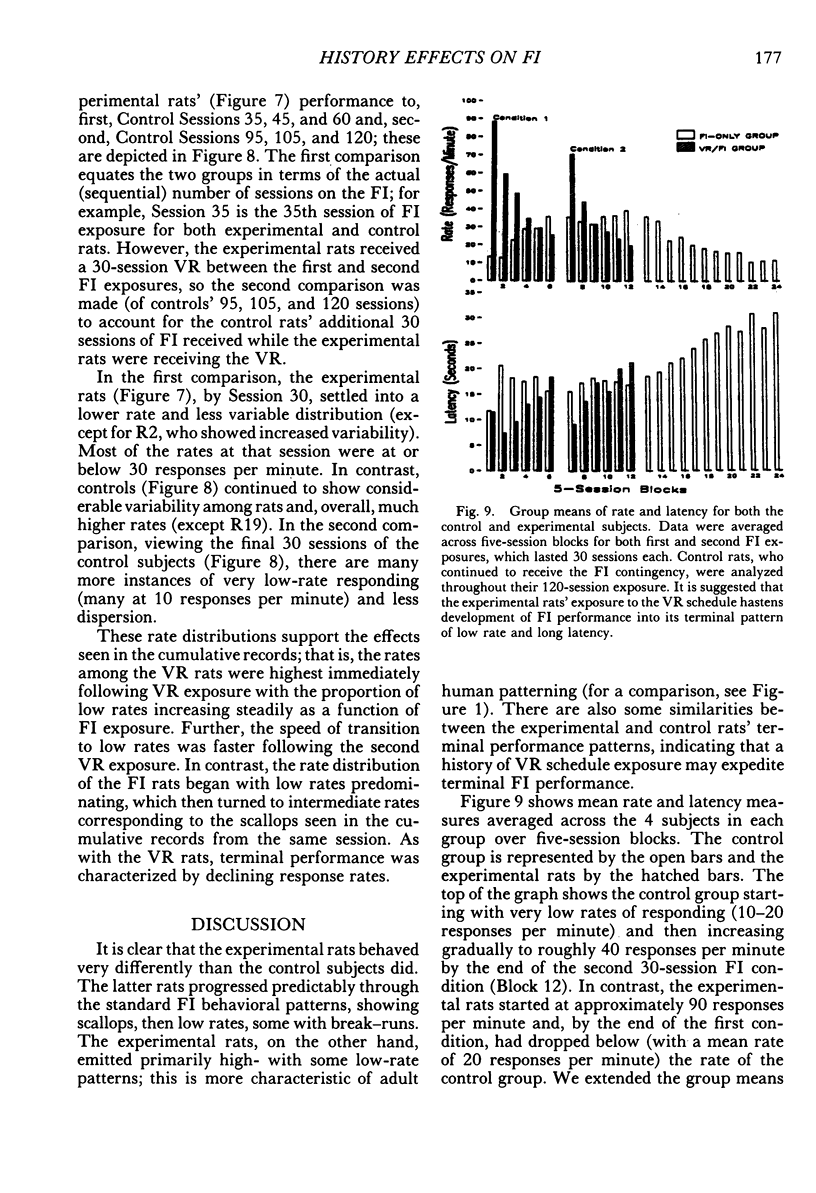
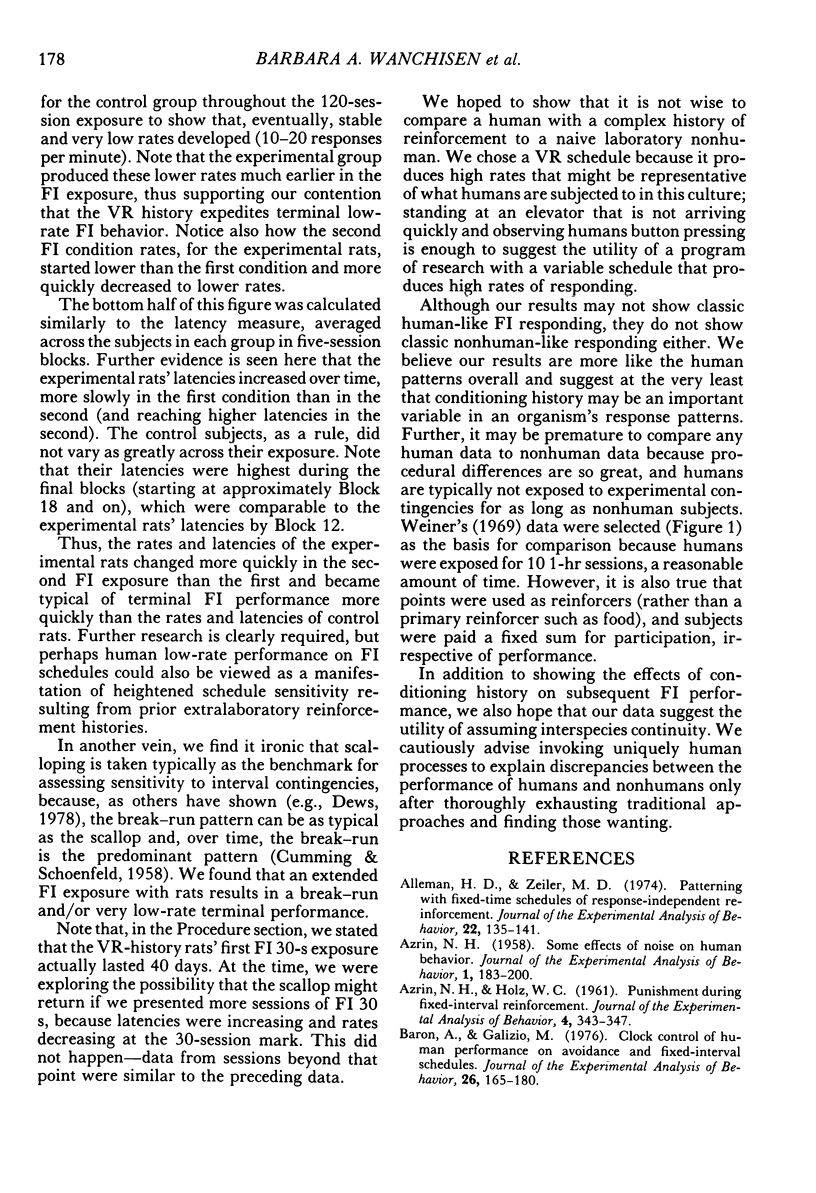
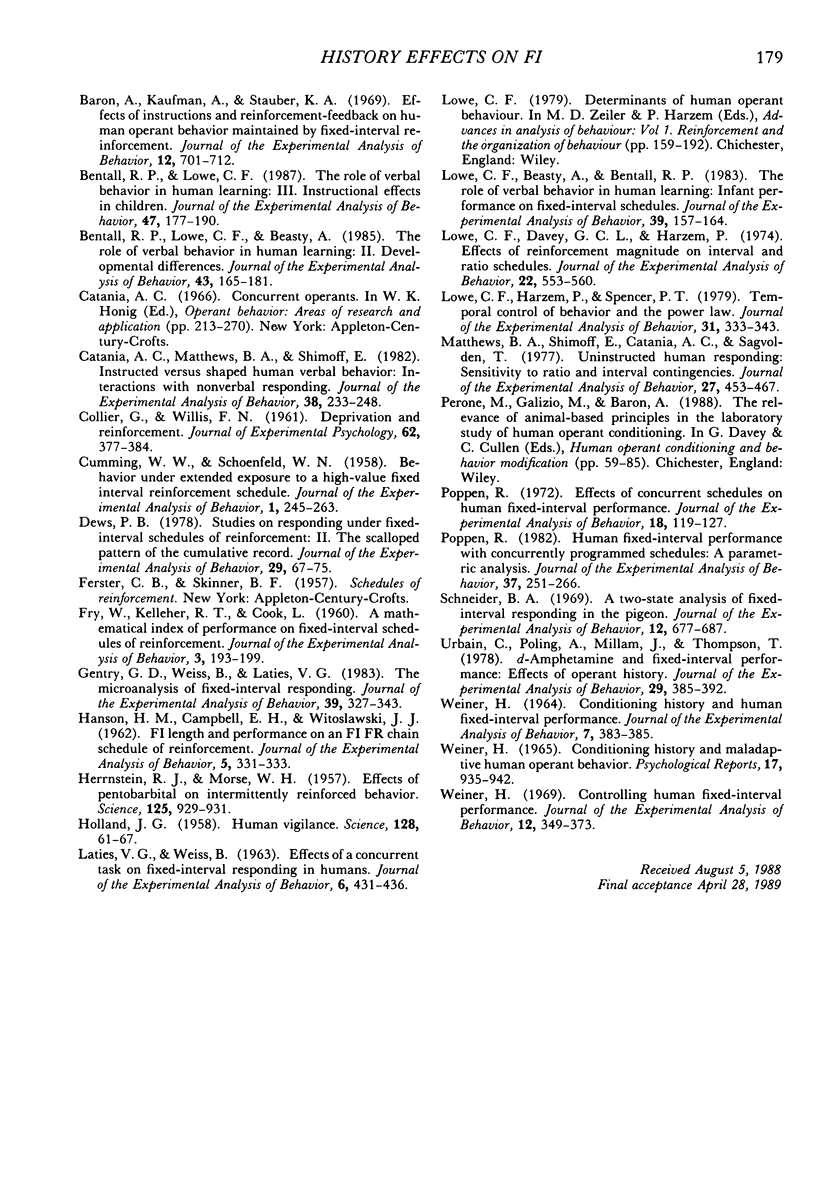
Selected References
These references are in PubMed. This may not be the complete list of references from this article.
- AZRIN N. H., HOLZ W. C. Punishment during fixed-interval reinforcement. J Exp Anal Behav. 1961 Oct;4:343–347. doi: 10.1901/jeab.1961.4-343. [DOI] [PMC free article] [PubMed] [Google Scholar]
- Alleman H. D., Zeiler M. D. Patterning with fixed-time schedules of response-independent reinforcement. J Exp Anal Behav. 1974 Jul;22(1):135–141. doi: 10.1901/jeab.1974.22-135. [DOI] [PMC free article] [PubMed] [Google Scholar]
- Azrin N. H. Some Effects of Noise on Human Behavior. J Exp Anal Behav. 1958 Apr;1(2):183–200. doi: 10.1901/jeab.1958.1-183. [DOI] [PMC free article] [PubMed] [Google Scholar]
- Baron A., Galizio M. Clock control of human performance on avoidance and fixed-interval schedules. J Exp Anal Behav. 1976 Sep;26(2):165–180. doi: 10.1901/jeab.1976.26-165. [DOI] [PMC free article] [PubMed] [Google Scholar]
- Baron A., Kaufman A., Stauber K. A. Effects of instructions and reinforcement-feedback on human operant behavior maintained by fixed-interval reinforcement. J Exp Anal Behav. 1969 Sep;12(5):701–712. doi: 10.1901/jeab.1969.12-701. [DOI] [PMC free article] [PubMed] [Google Scholar]
- Bentall R. P., Lowe C. F., Beasty A. The role of verbal behavior in human learning: II. Developmental differences. J Exp Anal Behav. 1985 Mar;43(2):165–181. doi: 10.1901/jeab.1985.43-165. [DOI] [PMC free article] [PubMed] [Google Scholar]
- Bentall R. P., Lowe C. F. The role of verbal behavior in human learning: III. Instructional effects in children. J Exp Anal Behav. 1987 Mar;47(2):177–190. doi: 10.1901/jeab.1987.47-177. [DOI] [PMC free article] [PubMed] [Google Scholar]
- COLLIER G., WILLIS F. N. Deprivation and reinforcement. J Exp Psychol. 1961 Oct;62:377–384. doi: 10.1037/h0047144. [DOI] [PubMed] [Google Scholar]
- Catania A. C., Matthews B. A., Shimoff E. Instructed versus shaped human verbal behavior: Interactions with nonverbal responding. J Exp Anal Behav. 1982 Nov;38(3):233–248. doi: 10.1901/jeab.1982.38-233. [DOI] [PMC free article] [PubMed] [Google Scholar]
- Cumming W. W., Schoenfeld W. N. Behavior under extended exposure to a high-value fixed interval reinforcement schedule. J Exp Anal Behav. 1958 Aug;1(3):245–263. doi: 10.1901/jeab.1958.1-245. [DOI] [PMC free article] [PubMed] [Google Scholar]
- Dews P. B. Studies on responding under fixed-interval schedules of reinforcement: II. The scalloped pattern of the cumulative record. J Exp Anal Behav. 1978 Jan;29(1):67–75. doi: 10.1901/jeab.1978.29-67. [DOI] [PMC free article] [PubMed] [Google Scholar]
- FRY W., KELLEHER R. T., COOK L. A mathematical index of performance on fixed-interval schedules of reinforcement. J Exp Anal Behav. 1960 Jul;3:193–199. doi: 10.1901/jeab.1960.3-193. [DOI] [PMC free article] [PubMed] [Google Scholar]
- Gentry G. D., Weiss B., Laties V. G. The microanalysis of fixed-interval responding. J Exp Anal Behav. 1983 Mar;39(2):327–343. doi: 10.1901/jeab.1983.39-327. [DOI] [PMC free article] [PubMed] [Google Scholar]
- HANSON H. M., CAMPBELL E. H., WITOSLAWSKI J. J. FI length and performance of an FI FR chain schedule of reinforcement. J Exp Anal Behav. 1962 Jul;5:331–333. doi: 10.1901/jeab.1962.5-331. [DOI] [PMC free article] [PubMed] [Google Scholar]
- HERRNSTEIN R. J., MORSE W. H. Effects of pentobarbital on intermittently reinforced behavior. Science. 1957 May 10;125(3254):929–931. doi: 10.1126/science.125.3254.929-a. [DOI] [PubMed] [Google Scholar]
- HOLLAND J. G. Human vigilance: the rate of observing an instrument is controlled by the schedule of signal detections. Science. 1958 Jul 11;128(3315):61–67. doi: 10.1126/science.128.3315.61. [DOI] [PubMed] [Google Scholar]
- Laties V. G., Weiss B. Effects of a concurrent task on fixed-interval responding in humans. J Exp Anal Behav. 1963 Jul;6(3):431–436. doi: 10.1901/jeab.1963.6-431. [DOI] [PMC free article] [PubMed] [Google Scholar]
- Lowe C. F., Beasty A., Bentall R. P. The role of verbal behavior in human learning: infant performance on fixed-interval schedules. J Exp Anal Behav. 1983 Jan;39(1):157–164. doi: 10.1901/jeab.1983.39-157. [DOI] [PMC free article] [PubMed] [Google Scholar]
- Lowe C. F., Davey G. C., Harzem P. Effects of reinforcement magnitude on interval and ratio schedules. J Exp Anal Behav. 1974 Nov;22(3):553–560. doi: 10.1901/jeab.1974.22-553. [DOI] [PMC free article] [PubMed] [Google Scholar]
- Lowe C. F., Harzem P., Spencer P. T. Temporal control of behavior and the power law. J Exp Anal Behav. 1979 May;31(3):333–343. doi: 10.1901/jeab.1979.31-333. [DOI] [PMC free article] [PubMed] [Google Scholar]
- Matthews B. A., Shimoff E., Catania A. C., Sagvolden T. Uninstructed human responding: sensitivity to ratio and interval contingencies. J Exp Anal Behav. 1977 May;27(3):453–467. doi: 10.1901/jeab.1977.27-453. [DOI] [PMC free article] [PubMed] [Google Scholar]
- Poppen R. Effects of concurrent schedules on human fixed-interval performance. J Exp Anal Behav. 1972 Jul;18(1):119–127. doi: 10.1901/jeab.1972.18-119. [DOI] [PMC free article] [PubMed] [Google Scholar]
- Poppen R. Human fixed-interval performance with concurrently programmed schedules: A parametric analysis. J Exp Anal Behav. 1982 Mar;37(2):251–266. doi: 10.1901/jeab.1982.37-251. [DOI] [PMC free article] [PubMed] [Google Scholar]
- Schneider B. A. A two-state analysis of fixed-interval responding in the pigeon. J Exp Anal Behav. 1969 Sep;12(5):677–687. doi: 10.1901/jeab.1969.12-677. [DOI] [PMC free article] [PubMed] [Google Scholar]
- Urbain C., Poling A., Millam J., Thompson T. d-amphetamine and fixed-interval performance: effects of operant history. J Exp Anal Behav. 1978 May;29(3):385–392. doi: 10.1901/jeab.1978.29-385. [DOI] [PMC free article] [PubMed] [Google Scholar]
- WEINER H. CONDITIONING HISTORY AND HUMAN FIXED-INTERVAL PERFORMANCE. J Exp Anal Behav. 1964 Sep;7:383–385. doi: 10.1901/jeab.1964.7-383. [DOI] [PMC free article] [PubMed] [Google Scholar]
- Weiner H. Conditioning history and maladaptive human operant behavior. Psychol Rep. 1965 Dec;17(3):935–942. doi: 10.2466/pr0.1965.17.3.935. [DOI] [PubMed] [Google Scholar]
- Weiner H. Controlling human fixed-interval performance. J Exp Anal Behav. 1969 May;12(3):349–373. doi: 10.1901/jeab.1969.12-349. [DOI] [PMC free article] [PubMed] [Google Scholar]


